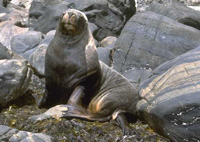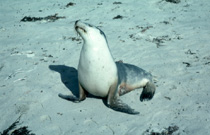Australian Sea Lion
(Neophoca cinerea)
IUCN STATUS (2010) - ENDANGERED
| Distribution and Numbers Found only in Australia and one of the most endangered pinnipeds in the world, there are estimated to be 10,000-12,000 Australian sea lions between The Pages Islands in South Australia and Houtman Abrolhos off the Western Australian coast. The species mostly inhabits islands but also a few mainland sites, the principal breeding colonies being located at Kangaroo Island and Dangerous Reef in South Australia. Wandering individuals have been sighted as far as New South Wales, Victoria, Tasmania and Shark Bay in Western Australia. The Australian sea lion is the most widely distributed and the least abundant pinniped in Australia. |
 Photo: Liz Poon, CSIRO Wildlife and Ecology |
| Status The species was heavily hunted for its hide and oil in the 18th and 19th centuries before which its range extended as far as the islands in Bass Strait. The Australian sea lion is now listed as Rare under South Australian legislation where it has received full legal protection since 1964 and has Special Protected Species status in Western Australia where it has been legally protected since 1892. The species has also been protected under national Australian legislation since 1975. Some small colonies in South Australia are protected by the Great Australian Bight Marine Park which was created in 1996 by the South Australian government and added to in 1998 by the national government. |
 Photo: Liz Poon, CSIRO Wildlife and Ecology |
Evidence is mounting that the size of the Australian sea lion population has levelled off and may be declining, and calls are being made for more intensive research into the species. Recent research has shown unexplained dramatic fluctuations in pup mortality rates which may be endangering the species. The pup mortality rate during the 1999 breeding season at the Dangerous Reef colony in South Australia, for example, was 41%, a record for the colony, and there are concerns that the colony's population is stagnating as a result. It is thought that the most likely cause of the high mortality at Dangerous Reef was infanticide by aggressive adult sea lions, other factors such as food shortages also being a possibility. However no definite cause has yet been found. |
| Entanglement in fishing nets, particularly shark nets, and crayfish pots is one of the main threats to the species. Concerns have also recently been raised about the siting of fish farms near sea lion haulouts or feeding areas. Some direct shooting of Australian sea lions occurs but the extent of this is unknown. Populations are highly susceptible to disturbance by humans, particularly during the breeding season. |
| Lifestyle Australian sea lions haul out and breed on rocks and sandy beaches, mainly on offshore islands. Individuals have been known to wander several kilometres inland. A long breeding season of about five months means that the males, unable to protect their territory continuously, spend up to four weeks ashore at a time maintaining small female groups, normally containing 4-6 females, and are very aggressive towards each other. The Australian sea lion has a unique breeding cycle amongst the pinniped species, the females giving birth to their pup after a 17.3-17.7 month cycle. A particular female's pupping season occurs in alternate summers and winters or in alternate springs and autumns, and the pupping season for different Australian sea lion colonies takes place at different times. |
| The females give birth a day or two after arrival and mate about a week later. Their pup is born with a chocolate brown coat which it moults at 4-6 months to be replaced by the adult coat which is dark brown apart from an area of blond fur on the head for males and silver-grey/brown on the back and creamy yellow underneath for females. About 10 days after the pup is born its mother starts going to sea to feed, spending about 2 days at sea and about 1.5 days back ashore, until the pup is weaned. Research suggests that the females feed in relatively shallow nearshore waters 20-30km offshore but probably also make some use of deeper offshore waters. The female nurses its pup for 15-18 months but some pups can be nursed for up to 23 months by the quarter of females who do not pup each breeding season. There is quite a high mortality of pups at the breeding grounds due to aggression by both male and female adults. |
| There is no evidence of migration or seasonal movements, apart from some movement of adult and subadult males on the west coast of Western Australia, and it appears that Australian sea lions tend to stay around their haulouts and breeding sites. Females may move with their pup to other haulout areas to nurse them. Little is known about the diet of Australian sea lions but cephalopods, crustaceans and fish are probably their major prey. Large sharks, especially white pointer sharks, are known to prey on Australian sea lions. |
| Statistics Adult males measure between 2-2.5m in length and weigh 250-300kg, while adult females measure between 1.3-1.8m in length and weigh 61-104kg. Pups are born measuring about 62-68cm in length and weighing 6.4-7.8kg. Research has shown a pup mortality rate in the first two years of 40-50%, a total of 20% of the pup mortality in the first six months being attributable to attacks from adult males. One adult male Australian sea lion was measured diving to a depth of 245m. Females become sexually mature at 4-6 years, males at 8-9 years. Australian sea lions are known to live for up to 25 years. |
 Photo: Michael Bryden, University of Sydney |
